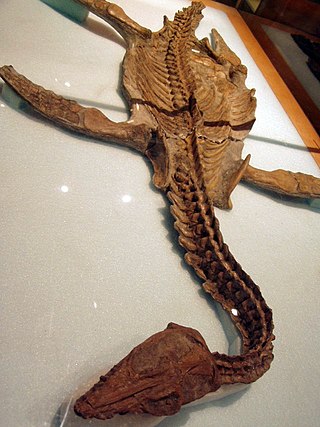
The Institute for Advanced Study (IAS) is an independent center for theoretical research and intellectual inquiry located in Princeton, New Jersey. It has served as the academic home of internationally preeminent scholars, including Albert Einstein, J. Robert Oppenheimer, Hermann Weyl, John von Neumann, and Kurt Gödel, many of whom had emigrated from Europe to the United States.

Gregory Scott Paul is an American freelance researcher, author and illustrator who works in paleontology. He is best known for his work and research on theropod dinosaurs and his detailed illustrations, both live and skeletal. Professionally investigating and restoring dinosaurs for three decades, Paul received an on-screen credit as dinosaur specialist on Jurassic Park and Discovery Channel's When Dinosaurs Roamed America and Dinosaur Planet. He is the author and illustrator of Predatory Dinosaurs of the World (1988), The Complete Illustrated Guide to Dinosaur Skeletons (1996), Dinosaurs of the Air (2001), The Princeton Field Guide to Dinosaurs (2010), Gregory S. Paul's Dinosaur Coffee Table Book (2010), The Princeton Field Guide to Dinosaurs: 2nd Edition (2016), The Princeton Field Guide to Pterosaurs (2022), The Princeton Field Guide to Mesozoic Sea Reptiles (2022) and editor of The Scientific American Book of Dinosaurs (2000).

Atrociraptor is a genus of saurornitholestine dromaeosaurid theropod dinosaur from the Late Cretaceous of Alberta, Canada.

Sinraptor is a genus of metriacanthosaurid theropod dinosaur from the Late Jurassic. The name Sinraptor comes from the Latin prefix "Sino", meaning Chinese, and "raptor" meaning robber. The specific name dongi honours Dong Zhiming. Despite its name, Sinraptor is not related to dromaeosaurids like Velociraptor. Instead, it was a carnosaur distantly related to Allosaurus. Sinraptor and its close relatives were among the earliest members of the Jurassic carnosaurian radiation. Sinraptor still remains the best-known member of the family Metriacanthosauridae, with some older sources even using the name "Sinraptoridae" for the family.

Shunosaurus, meaning "Lizard from Sichuan", is a genus of sauropod dinosaur from Late Jurassic (Oxfordian) beds in Sichuan Province in China, from 161 to 157 Million years ago. The name derives from "Shu", an ancient name for the Sichuan province.

Fukuisaurus is a genus of herbivorous ornithopod dinosaur that lived during the Early Cretaceous in what is now Japan. The type species is F. tetoriensis, which was named and described in 2003.

Albertaceratops was a genus of centrosaurine horned dinosaur from the middle Campanian-age Upper Cretaceous Oldman Formation of Alberta, Canada.

Nichollssaura is an extinct genus of leptocleidid plesiosaur from the Early Cretaceous Boreal Sea of North America. The type species is N. borealis, found in the early Albian age Clearwater Formation near Fort McMurray, Alberta, Canada.

The Princeton Tigers football program represents Princeton University and competes at the National Collegiate Athletic Association (NCAA) Division I Football Championship Subdivision (FCS) level as a member of the Ivy League. Princeton's football program—along with the football program at nearby Rutgers University—began in 1869 with a contest that is often regarded as the beginnings of American football.

Zanabazar is a genus of large troodontid dinosaurs from the Late Cretaceous of Mongolia. The genus was originally named by Rinchen Barsbold as the new species Saurornithoides junior. In 2009 it was reclassified as its own genus and species, Zanabazar junior, named after the first spiritual figurehead of Tibetan buddhism, Zanabazar. The holotype includes a skull, vertebrae, and right hindlimb. Zanabazar was one of the largest and most derived troodontids.

Erynnis icelus, also known as the dreamy duskywing or aspen dusky wing, is a species of butterfly in the family Hesperiidae. It is found in boreal North America, from the Northwest Territories east across southern Canada to Nova Scotia, south in the western mountains to southern Arizona and southern New Mexico, south in the east to Arkansas, north-eastern Alabama and northern Georgia.

The Princeton Field Guide to Dinosaurs is a reference work on dinosaurs written by the paleontologist and paleoartist Gregory S. Paul. It was first published by Princeton University Press in 2010. In the United Kingdom it was published by A & C Black under the title Dinosaurs: A Field Guide. An updated second edition was released in 2016. A third edition is set to release in 2024.

Chalcosyrphus (Xylotomima) inarmatus, the Yellow-haired Leafwalker, is an uncommon species of syrphid fly found across northern North America. Hoverflies are able to remain nearly motionless in flight. The adults are also known as flower flies for they are commonly found around and on flowers, from which they get both energy-giving nectar and protein-rich pollen.
Spilomyia foxleei is a species of syrphid fly in the family Syrphidae.
The 1944 Princeton Tigers football team was an American football team that represented Princeton University as an independent during the 1944 college football season. In its second and final season under head coach Harry Mahnken, the team compiled a 1–2 record and was outscored by a total of 40 to 22. Princeton played its 1944 home games at Palmer Stadium in Princeton, New Jersey.
Fluvionectes is a genus of elasmosaurid plesiosaur found in the Dinosaur Park Formation in Alberta, Canada. It is known from a holotype, which includes parts of the trunk area, and from a much larger specimen referred to this taxon.
Chalcosyrphus dubius is a species of syrphid fly in the family Syrphidae.
Chalcosyrphus femoratus is a species of syrphid fly in the family Syrphidae.
Xylota lovetti is a species of hoverfly in the family Syrphidae.
Brachyopa perplexa , The Hairy-striped Sapeater, is an uncommon species of syrphid fly. It has been observed from the Appalachian Mountains to New York and Quebec, Canada. Hoverflies get their names from the ability to remain nearly motionless while in flight. The adults are also known as flower flies, for they are commonly found around and on flowers, from which they get both energy-giving nectar and protein-rich pollen. Larvae for this genus are of the rat-tailed type. B.perplexa larvae have not been described.












